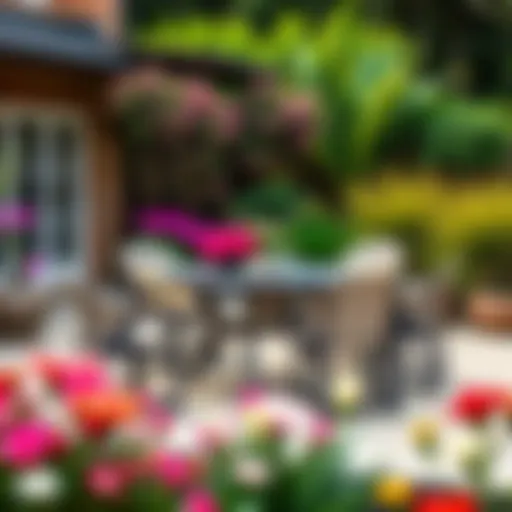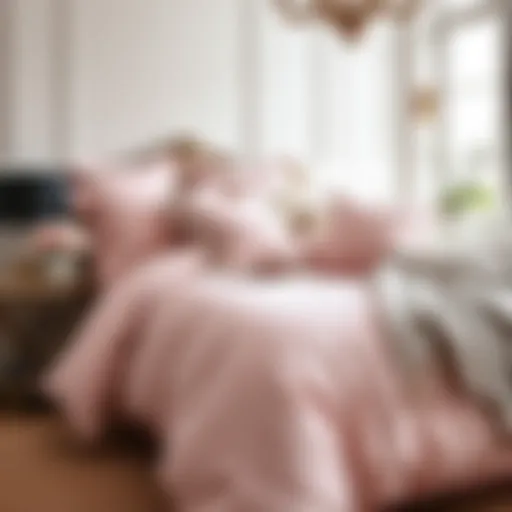Comprehensive Guide to Faux Leather Sofas with Chaise


Intro
In the vast landscape of furniture design, faux leather sofas with chaise lounges stand out as an attractive option for those who value style, comfort, and practicality. Offering the elegant look of genuine leather without the hefty price tag, these sofas can transform a living room into a cozy yet chic retreat. But beyond aesthetics, there is much more on the table—like sustainability, diverse design choices, and maintenance considerations.
This guide intends to unpack the essence of faux leather sofas with chaise lounges. It will provide valuable insight for homeowners, interior designers, and retailers, helping them navigate through the myriad of choices available. By understanding the current design trends, functional solutions, and upkeep tips, readers will feel empowered to make informed decisions that elevate their living spaces.
As we venture into the exploration of these furniture pieces, it's important to keep in mind that style is often personal. Faux leather couches are not just about making a statement; they should also fit into one's lifestyle seamlessly.
Let’s dive into the various aspects of faux leather sofas with chaise lounges that can help you in making that perfect choice for your home.
Intro to Faux Leather Sofas
Faux leather sofas have become something of a staple in modern furniture design. With an alluring combination of style, comfort, and practicality, these pieces have won over the hearts of homeowners and professionals alike. Not only do they offer the luxurious look of genuine leather, they also come with various tangible benefits that make them quite appealing. This section will delve into why faux leather sofas matter in today’s interior landscape and what considerations one might have when choosing this furniture option.
The Rise of Faux Leather in Furniture Design
In recent years, faux leather has gained significant traction in the world of furniture design. Several factors have contributed to this upward trend. First off, there is an increasing awareness about ethical consumerism. Many people look for alternatives to animal-derived materials and prefer products that align with their values. Faux leather often serves as a guilt-free choice without compromising on aesthetics.
Moreover, advancements in technology have led to high-quality faux leather options that closely mimic the texture and appearance of real leather. This means homeowners can enjoy the luxurious feel without the hefty price tag typically associated with genuine leather. Quality faux leather undergoes rigorous manufacturing processes that enhance its durability and maintain a polished appearance over time.
Another significant aspect is the affordability factor. Living spaces come in various shapes and sizes, and the price of furniture can vary widely as well. Faux leather sofas generally fall into a more budget-friendly category, making them accessible to a wider audience. This economic consideration allows homeowners to invest in a stylish sofa without needing to break the bank.
However, it’s also essential to note that not all faux leathers are created equal. Some might wear down quickly or show signs of damage in a short time. That said, doing a little homework on materials and manufacturers can guide consumers towards options that ensure longevity and satisfaction.
Understanding the Chaise Lounge Concept
The chaise lounge, a semi-reclined seating option, has captured attention for its blend of comfort and elegance. At its core, a chaise lounge allows for extended lounging or resting, making it a perfect choice for reading, napping, or simply unwinding after a long day. It takes the ordinary sofa to another level, as the extended seat can accommodate arbitrary lounging positions, promoting relaxation like no other.
Traditionally, chaise lounges come with unique design elements that make them stand out. From contemporary variants that boast sleek lines to classic styles that boast ornate detailing, the versatility of this furniture piece is unmatched. Often positioned at the end of a sofa or used on their own, they effortlessly add a chic touch to any living space.
For interior designers and architects, the incorporation of a faux leather chaise lounge can elevate a room’s functionality. They provide stylish options for both small spaces, where maximizing comfort is key, and larger rooms that demand visually striking furniture arrangements. Additionally, combining faux leather with different materials such as metal or wood can enhance the aesthetic appeal even further.
In summary, faux leather sofas with chaise lounges are more than just a practical choice; they embody trends of sustainability, comfort, and versatile style. Understanding the factors that have led to their rise and recognizing the utility of the chaise concept can guide consumers when decorating their homes.
"A well-designed space is not just about looks; it's about how the furniture functions within it."
As we explore deeper into the material composition, aesthetics, and functionality of these sofas, it will become increasingly clear how integral they have become to contemporary living.
Material Composition of Faux Leather
The material composition of faux leather plays a crucial role in defining the overall quality and usability of sofas, especially those with chaise lounges. Understanding the different types of faux leather not only enhances one’s options for style and durability, but also reflects a commitment to sustainable practices in furniture design. Therefore, navigating through the various materials helps in selecting the right sofa that fits both aesthetic preferences and practical requirements.
Types of Faux Leather
Faux leather comes mainly in three different types: Polyurethane (PU) leather, Polyvinyl Chloride (PVC) leather, and microfiber leather. Each of these has unique traits, offering various benefits and a few drawbacks.
Polyurethane (PU) Leather
Polyurethane leather is often regarded as a superior choice among faux leathers. Its key characteristic lies in its ability to closely mimic the look and feel of real leather without the associated ethical concerns. PU leather is breathable, making it a preferred option for furniture that faces regular use and wear.
One unique feature of PU leather is its versatility in design, allowing for various textures and colors. This adaptability makes it an appealing option for modern decor trends. While PU leather is generally durable, it may require more care than PVC in terms of maintenance to prevent cracking over time. Despite this, its luxurious feel keeps it popular in homes and showrooms alike.
Polyvinyl Chloride (PVC) Leather
Polyvinyl Chloride leather brings a different set of advantages to the table. Its key characteristic is its impressive durability, which makes it resistant to water and stains. This aspect is particularly appealing for homes with pets or children, where spills and messes are a common occurrence.
A unique feature of PVC leather is its affordability compared to other materials. This makes it an accessible choice for homeowners on a budget who still want a modern look. However, the trade-off with PVC is often in comfort, as it doesn't have the same breathability or soft touch as PU. Therefore, while it stands strong in terms of durability, the overall comfort might take a slight hit, especially in warmer environments.
Microfiber Leather
Microfiber leather is yet another contender in the realm of faux leather. The key characteristic of microfiber is its fine weave, which provides a soft and supple texture. It’s highly resistant to wear and tear, making it suitable for high-traffic areas.
The unique feature of microfiber leather is its ease of cleaning—often just a quick wipe is necessary to keep it looking fresh. Additionally, it is less prone to developing stains, which makes it practical for everyday use. However, one disadvantage can be its sensitivity to heat, as direct exposure to sunlight may cause fading over time. This fact should be considered when placing microfiber sofas in bright living spaces.
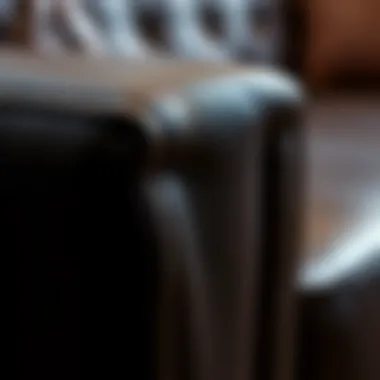
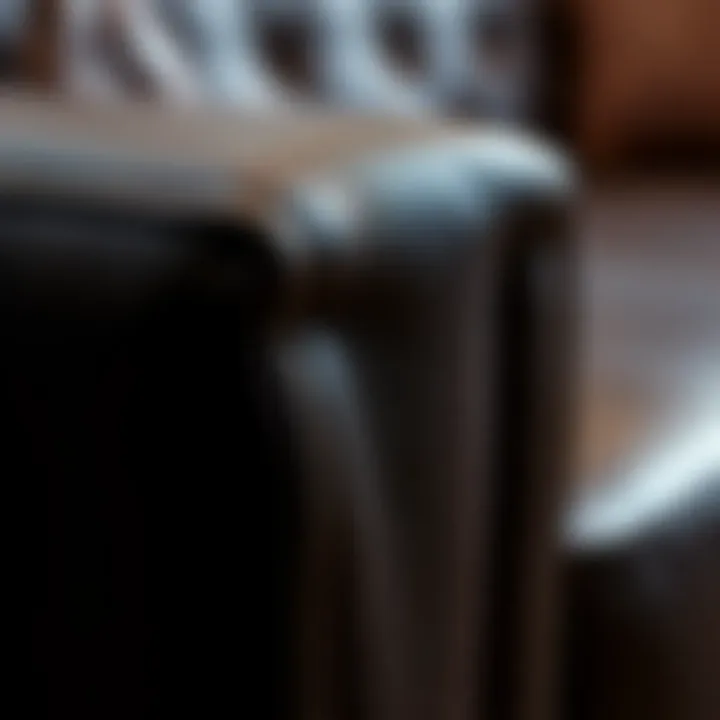
Sustainability Aspects
Sustainability is an integral aspect of modern furniture selection. Examining the environmental impacts of various materials can guide choices that contribute positively to both personal spaces and the planet.
Environmental Impact
The environmental impact of faux leather is an essential point in the broader discussion of sustainability in furniture. While traditional leather production is often linked to high resource consumption and ethical concerns regarding animal welfare, faux leathers generally present a more sustainable alternative. PU and microfiber leathers, when produced responsibly, can be less taxing on the environment. However, PVC leather raises some environmental flags due to its production process, which may include harmful chemicals.
Considering alternatives that prioritize eco-friendliness can encourage manufacturers to innovate toward less damaging methods, enhancing the positive effects of faux materials in furniture production.
Recyclability and Disposal Options
Exploring recyclability and disposal options is another critical aspect of faux leather materials. Unlike genuine leather, which is biodegradable, some faux options may take longer to break down in landfills. Yet, many manufacturers are beginning to recognize the importance of producing materials that can be recycled effectively.
Products like PU leather might offer better recyclability than PVC, leading to less overall waste. In the case of microfiber, while it can be challenging to recycle, proper disposal methods are developing alongside the increase in awareness about sustainable practices. Individuals should consult local regulations and recycling programs to ensure they are disposing of their furniture in the most responsible way possible.
Design Aesthetics of Faux Leather Sofas with Chaise
The design aesthetics of faux leather sofas with chaise lounges play an essential role in defining the overall ambiance of a living space. It’s not just about comfort; it's about creating a visual narrative that aligns with a homeowner's taste and the practical needs of their lifestyle. Faux leather, with its myriad textures and styles, allows for creativity and personalization while maintaining an air of sophistication.
When selecting a faux leather sofa with chaise, understanding the aesthetic trends can greatly influence decisions. Style, color, and fabric choice are not only markers of personal taste but also indicative of the trends in furniture design. This section will explore various styles and trends, along with color options and customization to help readers make informed choices.
Styles and Trends
Contemporary Designs
Contemporary designs often reflect current trends and styles, focusing on minimalism and clean lines. A characteristic of contemporary faux leather sofas is their sleek appearance and functional forms. These designs are beneficial for modern households that prefer a clutter-free aesthetic.
One unique feature of contemporary designs is their versatility. They can seamlessly blend into any room, whether it's a compact apartment or a spacious home. However, one downside might be that the focus on minimalism sometimes leads to a lack of warmth, which can make a space feel cold, depending on the color and materials used.
Mid-Century Modern Influences
Mid-century modern influences bring a nostalgic yet timeless appeal to faux leather sofas. The hallmark of this style is the use of organic shapes, with an emphasis on functionality and simplicity. This design choice has become increasingly popular due to its ability to add character without overwhelming a room's decor.
Mid-century styles are often vibrant, showcasing bold colors complemented by wood or metal accents, making them an exciting choice for those looking to express individuality. While they are visually striking, these pieces can clash with more traditional furnishings, which might limit their adaptability in certain design schemes.
Classic Elegance
Classic elegance evokes a sense of tradition and refinement, often celebrated in timeless shapes and rich textures. Faux leather sofas designed with classic elegance in mind usually feature decorative elements such as tufting and ornate legs, which can elevate the look of any room.
The key characteristic of this style is its ability to transcend trends, offering longevity in design. This durability can be advantageous for buyers looking for pieces that will endure stylistic changes over the years. However, classic elegance can sometimes feel quite formal, which may not suit every individual’s taste or lifestyle.
Color Options and Customization
Neutral Tones
Neutral tones are often favored for their ability to create a calm backdrop in any room. Sofas in shades like beige, gray, or taupe can be incredibly versatile, easy to incorporate into various design themes. Their understated appearance makes them a beneficial choice for those looking to maintain a serene and cohesive aesthetic.
The unique aspect of neutral tones lies in their capacity to provide a foundational palette that allows for easy decoration with accessories, such as colorful cushions or art pieces. However, the downside may be that they could come off as bland or lacking personality if not accented cleverly.
Bold Colors
Bold colors can make a striking statement in any room—think deep greens, vibrant blues, or intense reds. Choosing a faux leather sofa in one of these shades adds a pop of vibrancy, drawing attention and possibly becoming a focal point of the space. It's an ideal choice for those wishing to channel a lively and dynamic atmosphere.
The standout feature of bold colors is their ability to energize a space. However, they may risk overwhelming a smaller room if not balanced with other tones or elements, creating a cluttered feel if not accessorized thoughtfully.
Patterned Fabrics
Patterned fabrics provide yet another layer of design aesthetics, offering uniqueness that can truly express personality. Faux leather sofas with patterns, whether geometric, floral, or abstract, can introduce an unexpected twist to conventional sitting arrangements. This can be particularly appealing in eclectic homes or those aimed at creating a fun and artistic vibe.
A major benefit of patterned fabrics is their ability to hide wear and tear better than solid colors, making them a wise choice for families with children or pets. However, one should keep in mind that patterns can sometimes limit the ability to easily change a room's style without investing in new furniture.
"The beauty of faux leather sofas lies not only in their affordability and versatility but also in the way they can adapt to various design aesthetics, meeting both functional needs and personal style."
In summary, the design aesthetics of faux leather sofas with chaise lounges are a critical factor in creating stylish and functional living spaces. From the trending styles and colors to the benefits and drawbacks of each option, understanding these elements can greatly aid in selecting the perfect piece for one's home.
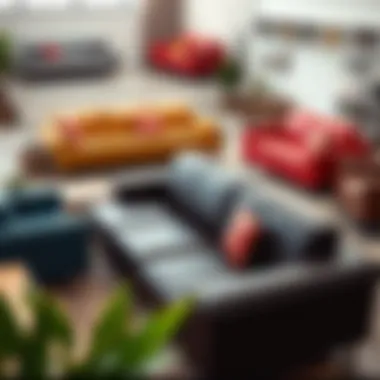

Functionality and Comfort
In the realm of furniture, functionality and comfort play a pivotal role, especially when it comes to faux leather sofas with chaise lounges. Homeowners today seek not only aesthetics but also practicality and ease of use in their living environments. Choosing the right sofa can transform a room from simply a space to an inviting haven. In this guide, we dissect the elements that contribute to the intricate relationship between functionality and comfort in these modern furnishings, assisting you in making an informed decision.
Ergonomics of Chaise Lounges
Posture Support
Posture support is a crucial element in the design of chaise lounges, particularly for buyers who spend long hours seated. A well-designed chaise encourages a natural spinal alignment, reducing the chances of back pain or discomfort. While sitting back, the extended leg rest provides a welcomed elevation that helps to alleviate pressure on one’s lower back.
One key characteristic of effective posture support is the contoured design of the seating area. Instead of a flat surface, a chaise lounge may boast curves accommodating the body’s natural shape. This design choice is not just popular; it’s a fundamental aspect of ergonomic furniture. It’s often favored by those who prioritize well-being in their living spaces, as it emphasizes both form and comfort.
Moreover, the unique feature of adjustable cushions can further enhance posture support, allowing users to modify their lounging position according to personal preference. However, while many prefer soft cushions for comfort, it’s important to choose a material that doesn’t sacrifice too much support. If the cushioning sinks too deeply, it could lead to discomfort over time.
Adaptability for Different Spaces
Adaptability for different spaces is another vital aspect of faux leather sofas with chaise. The unique versatility of this furniture caters well to both large, spacious areas and small, tight quarters. Sofas that can seamlessly blend into various layouts or configurations are considered invaluable in today’s dynamic home environments.
The modular nature of many chaise lounges allows for effortless rearrangement, adapting to the ever-changing needs of a household. This is particularly beneficial for multi-functional spaces, where flexibility is required. By enabling different seating arrangements, adaptability encourages not only a diverse use of space, but also fosters an inviting ambiance tailored to gatherings or quiet relaxation.
However, it’s essential to note that while adaptability is a considerable strength, it can come with a trade-off; larger or more modular sofas might consume significant floor space, which can be a concern in smaller homes. Therefore, weighing space and functional needs is necessary before making a purchase.
Space Optimization Techniques
Small Space Solutions
In smaller homes, optimizing space can feel like solving a puzzle. Small space solutions provided by faux leather sofas with chaise lounges offer creative ways to maximize utility without compromising on style. These sofas often come in designs that incorporate stylish storage options, allowing users to hide away blankets, books, or other items while maintaining an uncluttered environment.
A distinctive feature of these sofas is their compact build. Unlike traditional sofas, which can overwhelm cramped areas, many faux leather models are designed to fit snugly without sacrificing comfort. This makes them a preferred choice among urban dwellers who often face space constraints. The advantage here lies in the ability to maintain a comfortable setting while effectively utilizing the area.
Open Concept Living
Open concept living has gained popularity, especially in modern architectural designs. Chaise lounges serve as the practical centerpiece in these large, flowing spaces. Their shape allows for segregation of zones without the need for physical barriers. You can mark out a cozy reading corner or a lively conversational area with strategic placement.
The hallmark of open concept living is its fluidity. It promotes a seamless transition between areas, encouraging a sense of connection in the living space. However, while this feature is advantageous, it can also lead to noise and a lack of privacy. Thus, careful planning of color schemes and materials can help in mitigating any potential sound issues, ensuring the area remains welcoming and tranquil.
Quality and Durability Considerations
When it comes to selecting a faux leather sofa with a chaise, understanding the quality and durability of the materials and construction is paramount. This section will delve into why this aspect merits careful consideration, looking at elements that not only affect the lifespan of the piece but also its overall performance and satisfaction in your living space.
Evaluating Construction Quality
The construction quality of a faux leather sofa encompasses how well the piece is made, highlighting the craftsmanship that goes into its design. A sofa is often an investment, and the right sofa should stand the test of time. First, when assessing construction, pay attention to the frame. A sturdy frame typically made from solid hardwood or metal ensures durability and a longer lifespan.
Next, consider the stitching and upholstery. Double-stitched seams are a sign of good quality and can help prevent the material from fraying or tearing. Checking the cushioning is also vital—density matters. High-density foam cushions often provide better support and retain their shape longer than lower-density alternatives.
In sum, investing time in evaluating the construction quality ensures a purchase worth your hard-earned money, enhancing your overall experience with functionality and comfort.
Maintenance Tips for Longevity
Cleaning Techniques
Cleanliness plays a significant role in extending the life of your faux leather sofa. A simple yet effective cleaning technique involves using gentle soap mixed with warm water. This concoction can easily remove day-to-day stains and grime without damaging the finish. Just use a soft cloth to apply the solution, followed by a clean cloth to wipe away any residue.
It’s advisable to avoid harsh chemicals, as they can strip the faux leather of its luster. Instead, regular dusting using a microfiber cloth maintains not just appearance but also prevents dirt buildup. A key aspect is that these cleaning techniques can be done quickly, making it a practical choice for busy lifestyles.
Moreover, it’s worth noting that while these techniques seem straightforward, they provide you with a unique edge in ensuring your faux leather remains supple and vibrant for years.
Protective Measures
Protection is as crucial as cleaning when it comes to longevity. Utilizing a protective spray specifically designed for faux leather can create a barrier against spills and stains. Such protective measures often repel liquids, meaning that a quick wipe-down will suffice should an accident occur.
A standout feature of these protective sprays is their ability to enhance the texture and appearance of the faux leather without changing its qualities. Many consumers report an increase in durability after applying these products, making them a popular choice for those looking for longevity. The downside could be that some sprays might require periodic reapplication, but the initial investment goes a long way in safeguarding your furniture.
Comparative Analysis: Faux Leather vs. Genuine Leather


When it comes to choosing furniture, understanding the materials is essential. This section delves into the key differences between faux leather and genuine leather, spotlighting why such knowledge matters for anyone in the market for furniture, especially interior designers and retailers.
Faux leather, a synthetic alternative, may be appealing for its affordability and ease of maintenance. In contrast, genuine leather boasts a classic allure and unmatched durability, but often at a steeper price. Each type carries its own set of benefits and considerations, which can influence the buyer’s decision.
Cost-Benefit Analysis
When weighing options, price plays a pivotal role. Faux leather sofas often come at a fraction of the cost of genuine leather. For buyers conscious about budget, this price difference could be a game changer.
- Affordability: Faux leather typically ranges from $300 to $1,200, while genuine leather can start from $1,500 and go upwards.
- Long-Term Investment: Genuine leather may require a bigger investment initially, but it also tends to outlast faux leather, potentially saving money in the long run.
- Maintenance Costs: Cleaning and maintaining genuine leather involves special products, while faux leather only needs a simple wipe down with a damp cloth.
Performance in Various Conditions
The performance of these materials can widely vary based on usage and environment.
- Durability: Genuine leather is lauded for its toughness. It can withstand wear and tear better than faux leather, making it suitable for high-traffic areas.
- Water Resistance: Faux leather has a big advantage here; it can handle spills without immediate damage. Genuine leather, however, can stain if moisture is not immediately addressed.
- Temperature Sensitivity: In hot weather, genuine leather can feel warm and sticky, while faux leather remains cool.
Moreover, faux leather is often considered a better option for pet owners due to its resistance to scratches and stains. However, genuine leather tends to develop a unique patina over time, enhancing its character, which many people find appealing.
"When it comes to your furniture choice, evaluating both aesthetic and practical factors will lead to the best decision for your lifestyle."
Consumer Insights and Reviews
Understanding consumer insights and reviews is paramount when navigating the realm of faux leather sofas with chaise lounges. These perspectives serve as the pulse of the market. They allow potential buyers to peek behind the curtain, obtaining genuine appraisals concerning product performance, longevity, and overall satisfaction. By sifting through this firsthand feedback, homeowners, interior designers, and retailers alike can make educated choices that align with the preference and requirements of their space.
Consumer reviews can illuminate various aspects of faux leather sofas, such as:
- Quality Assessments: Reviews often highlight the materials used, revealing whether the sofa has stood the test of time or if it's an instance of superficial charm that wears out quickly.
- Comfort Levels: Insights into seating comfort and support are invaluable. Users share their everyday experiences, helping others gauge if these pieces meet ergonomic needs.
- Design Feedback: Many reviews focus on aesthetic appeal, mentioning how well the sofa fits into diverse decor styles and personal tastes.
"Consumer experiences offer a unique, real-world perspective that can overshadow marketing claims, providing clarity on what consumers can genuinely expect."
Taking these reviews seriously can profoundly impact product selection and marketing strategies, ensuring companies design offerings that resonate with what buyers truly want.
User Experiences and Feedback
When diving into user experiences, one can uncover a treasure trove of insights. Customers often share stories that highlight everyday usage, revealing how well the faux leather sofas integrate into their lives. For instance, a busy family might emphasize how easy the material is to clean after a snack spill or a toddler's antics. In contrast, a young professional may comment on the style and versatility of a chaise lounge that perfectly fits their compact apartment.
Positive feedback might include aspects such as:
- Affordability: Many users describe faux leather sofas as cost-effective alternatives to genuine leather, providing similar luxury without breaking the bank.
- Maintenance Ease: The general consensus is that faux leather usually requires lesser upkeep than its authentic counterpart, which significantly appeals to individuals who prefer low-maintenance solutions.
- Stylistic Variance: Users appreciate the extensive options, from minimalist designs to vibrant colors, ensuring that there’s a style for every taste.
However, it’s essential to listen not just to commendations, but also to constructive criticisms.
Commonly Reported Issues
While faux leather sofas present numerous advantages, it’s only fair to acknowledge the challenges reported by consumers. Learning about these hiccups can assist prospective buyers in making informed choices.
- Durability Concerns: Some users have noted that certain faux leather sofas may peel or crack over time, especially when exposure to sunlight is frequent. It’s important to consider placement in relation to natural light.
- Odor Issues: Occasionally, new faux leather products may emit a chemical scent. Though often temporary, this can be off-putting for sensitive individuals.
- Color Fading: A few reviews mention that colors may fade with prolonged exposure to UV light, making it critical to assess the ideal location in one’s residence.
In summary, engaging with consumer insights and reviews presents a nuanced view of faux leather sofas with chaise lounges. This perspective not only shapes buyer expectations but also guides manufacturers in refining their offerings for enhanced customer satisfaction. Navigating through these personal narratives enriches the understanding of how these furniture pieces perform in practical settings, thus empowering informed purchasing decisions.
Epilogue and Recommendations
In wrapping up our detailed exploration of faux leather sofas with chaise lounges, it's crucial to reflect on the numerous benefits this furniture offers, especially for interior designers, architects, and retailers. As we navigate through design choices, understanding material characteristics, and maintenance implications, a well-considered decision can elevate both comfort and aesthetic appeal in any space.
Selecting the right sofa is not merely a matter of personal taste, but a strategic choice that can influence the overall ambiance of your living area. Whether you're redecorating a cozy apartment or designing a spacious lounge area, taking dimensions and layout into consideration is critical. A faux leather chaise does not just offer a place to sit; it serves as a statement piece that complements your design intent. Here are some vital elements to contemplate:
- Size and Shape: Ensure the sofa fits perfectly into your designated area. Measure the space from various angles and consider the flow of movement. A well-placed chaise can become a focal point or blend seamlessly with the decor.
- Color and Texture: Choose colors that harmonize with your existing palette. Faux leather comes in an array of hues, allowing for expressive color choices that can brighten or ground a room.
- Durability and Care: Assess the durability factors based on your lifestyle. Faux leather can mimic the luxurious feel of genuine leather without the upkeep demands. Regular maintenance, such as cleaning with gentle products, will prolong the life of your sofa.
Perfect Fit for Your Space
Identifying the perfect faux leather sofa with chaise for your living environment hinges on understanding both the physical dimensions of your space and your personal preferences. While the idea of a chaise lounge conjures images of luxury and relaxation, the reality is that not every model fits every room. Here are pointers to ensure you’re making the most fitting choice:
- Room Layout: Consider if your living area leans towards open-concept or segmented designs. A chaise can effectively delineate spaces if placed thoughtfully. In open layouts, a modular design can create a natural divide.
- Lifestyle Considerations: Families with young children or pets might prioritize fabrics that can withstand wear, while those hosting more formal gatherings may desire a more elegant appearance.
- Complementary Pieces: Look at how the sofa will coexist with existing furniture. Ensuring balance in size and style can create a harmonious visual flow within the space.
Ensuring your faux leather sofa with chaise is the perfect fit is about blending practical considerations with your unique style. References for spatial planning can be found in resources like Wikipedia.
Future Trends in Faux Leather Furniture
As the furniture industry continues to evolve, the prospects for faux leather, particularly in designs featuring chaise lounges, appear bright. Several trends surface when considering the future trajectory of this material:
- Innovative Materials: Advances in faux leather technology promise improved durability and even eco-friendliness. Expect to see materials that not only mimic the look of genuine leather but also have superior breathability and comfort.
- Sustainability Focus: As consumer preferences shift towards sustainable living, manufacturers are incorporating recycling and environmentally friendly practices into their production lines. The trend points towards using less harmful chemicals and renewable resources.
- Customization: Homeowners will likely seek more personalized products. Furniture brands may respond by offering bespoke solutions in terms of color, texture, and configuration, allowing for a deeper engagement with buyers.



